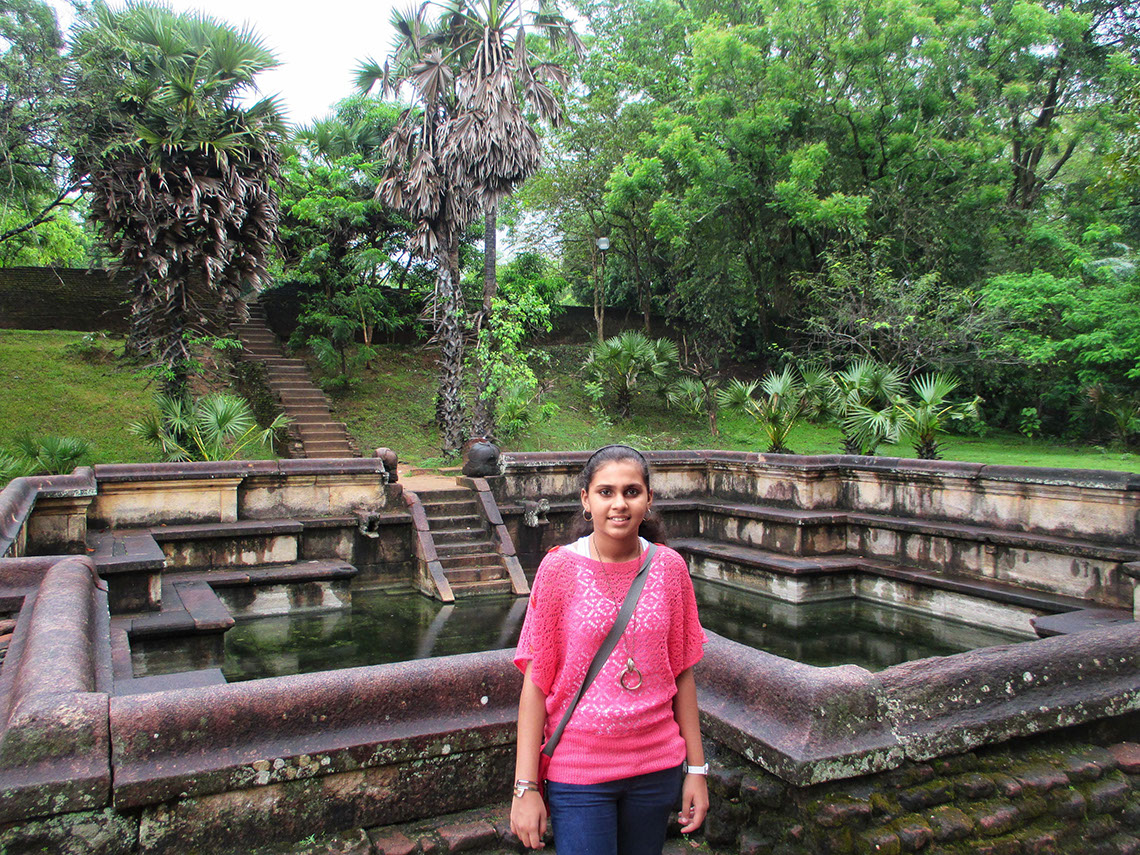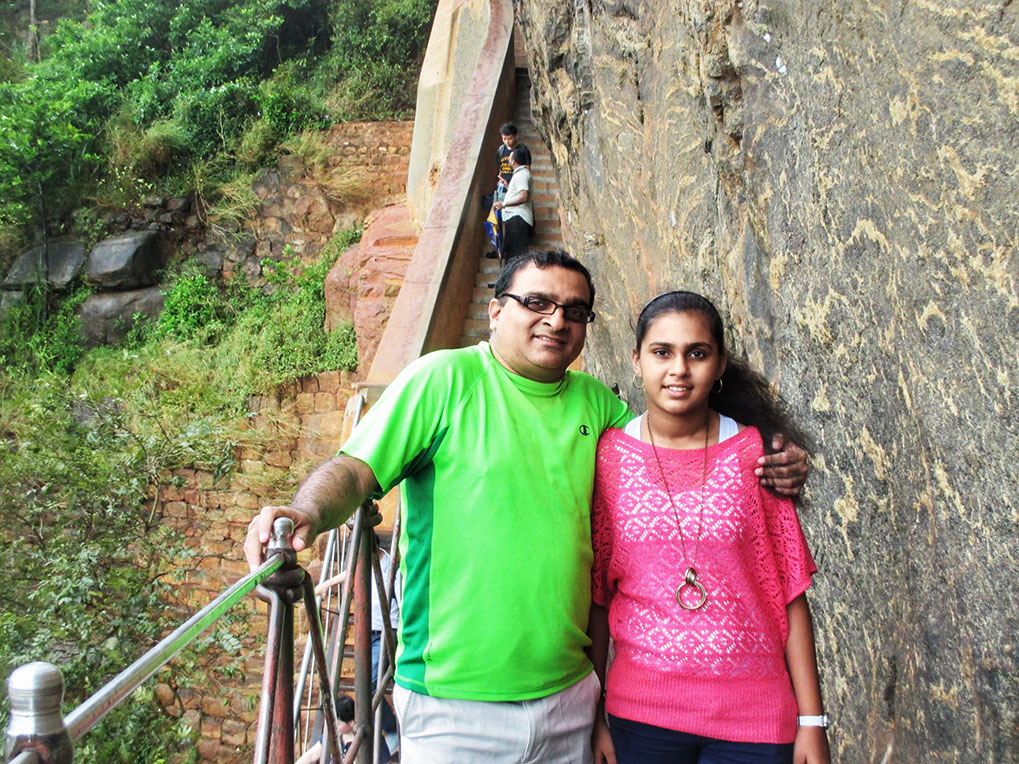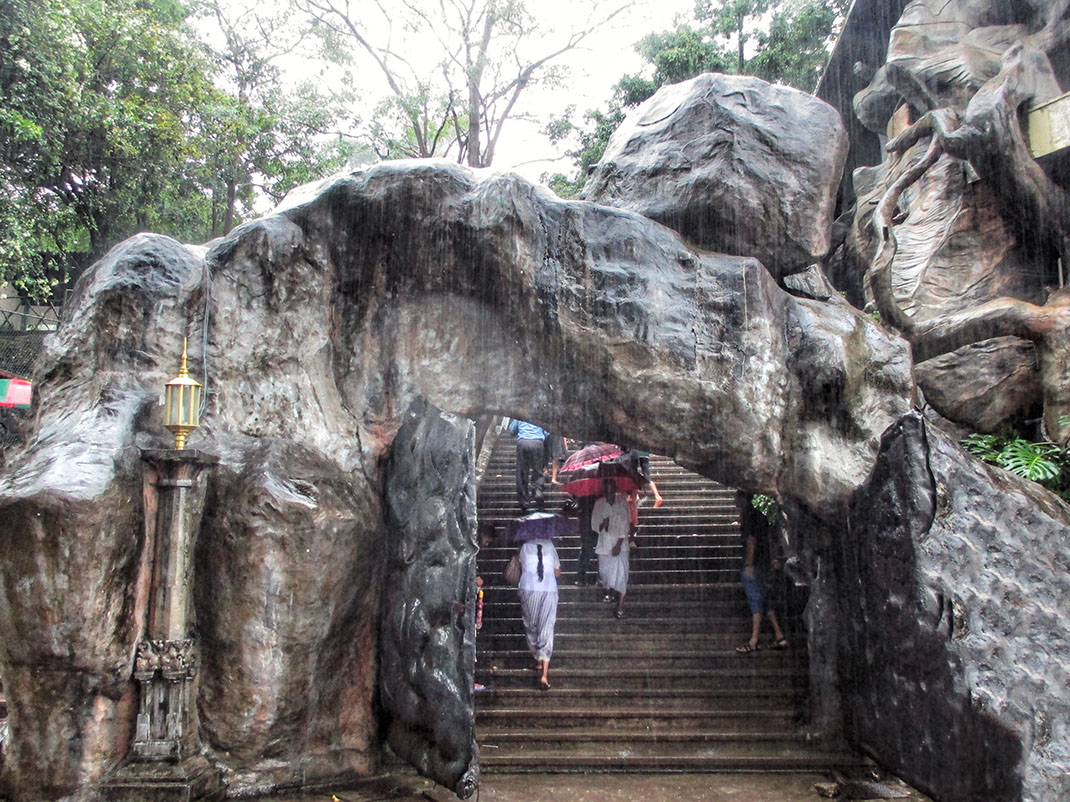
Thank you for stopping by and reading my story. Sri Lanka has managed the heritage sites very well and that makes a big difference. I'm sure you will enjoy your visit.
776 views

A tiny pear-shaped island, Sri Lanka is culturally affluent with some of the most incredible UNESCO World Heritage Sites. There are eight UNESCO Heritage Sites in this exotic island out of which six are cultural sites and two are natural sites. The cultural sites are the ancient city of Polonnaruwa (1982), the ancient city of Sigiriya (1982), the Temple of Dambulla (1991), the old town of Galle and its fortifications (1988), the sacred city of Anuradhapura (1982), the sacred city of Kandy (1988). The natural sites are Sinharaja Forest Reserve (1988) and the Central Highlands of Sri Lanka (2010). While in Sri Lanka, one must explore and experience these spectacular places.
After a rather splendid time spent enjoying the natural beauty of this exotic island, it was now time to explore the UNESCO World Heritage Sites of Sri Lanka. My daughter and I traveled to the ancient city of Polonnaruwa. This was the first of the 3 UNESCO World Heritage Sites that we planned on visiting.
One of the lesser-known cities in Sri Lanka, Polonnaruwa was a thriving commercial and religious center about 800 years ago. A UNESCO world heritage site, the ancient city of Polonnaruwa is situated in the main town of Polonnaruwa in North Central Province. Reaching there, we were surrounded by ruins that spoke of architectural excellence. This city was established by the Chola dynasty after their invasion of the country in the 10th century. Under this period, systematic destruction of the Buddhist civilization took place in the northern plains of Sri Lanka. Today it remains one of the best-planned archaeological relic cities in the country. Our well informed guide narrated the history and other interesting snippets as we wandered around the ruins of this ancient city. While I would recommend visiting Polonnaruwa with a knowledgeable guide, we did come across several adventurous tourists, especially backpackers, who had rented bicycles and were exploring the ancient city on their own.

The Ancient city of Polonnaruwa and The Royal Palace also known as the Vijayotpaya
The perfect prelude to the actual site visit is a visit to the Archeological Museum, where there is a display of models of each important site. This is right next to the ticket office. It builds up the story for your visit to the ancient city of Polonnaruwa. We visited the museum in the end and realized that it should have been the other way around. However, our knowledgeable guide more than compensated for it and made our visit memorable. We were amazed at the architectural excellence displayed and attention to detailed designs was astonishing. There are several groups of ruins that we visited that I will share below.
Declared a UNESCO World Heritage Site in 1982, Polonnaruwa Royal Palace was built by King Parakramabahu. Although what we see are ruins of an incredible structure, it is still mind blowing. Constructed in the 10th century, this 7-storied architectural marvel is believed to have consisted of 1,000 chambers. Today, the crumbling ruins have around 55 halls and three floors, which led to speculation that the top floors were possibly constructed with wood. The king's Audience Hall with its intricately carved elephants on the walls is well preserved. We could feel the ambience of royalty and grandeur while standing in this grand place.

Entrance to the Audience Hall of Polonnaruwa Royal Palace, a UNESCO World Heritage Site

My daughter among the stone pillars of the Audience Hall
Spotting a water body, my daughter enquired about it and our guide enlightened us that it was the king's swimming pool. Located outside the southeast corner of the Royal Palace grounds, it was a well-designed pool surrounded by lush greenery. The pool known as Kumara Pokuna has crocodile-mouth spouts that used to feed fresh water into the pool. It was a luxurious recreational spot for the king.

Symmetrically designed impressive king's swimming pool in the ancient city of Polonnaruwa

The king's swimming pool surrounded by verdure looks equally beautiful from the other side
Mesmerized by the ambience and impressed by the fancy lifestyle of the royals, we headed to the Sacred Quadrangle. This place has the most accumulated buildings in the entire ancient city of Polonnaruwa. It encompasses a group of attractive ruins that are raised up on a platform. We climbed up and there in the center of the quadrangle is a circular relic structure called the Vatadage. The grand patio is an incredible 18m in diameter with four entrances. These entrances are bordered by guard rocks that are well preserved. We were fascinated by the superior craftsmanship of the place.

The Polonnaruwa Vatadage, a circular relic house at the Quadrangle

Sandakada pahana, translated as "Moonstone"- an elaborately carved semi-circular stone slab commonly seen at the bottom of staircases and entrances; a unique feature of the Sinhalese architecture
This well preserved structure is a stupa locally known as a dagaba. This stunning structure is believed to be built by queen Rupavathi, one of king Parakramababu's consorts. This stupa is the third largest in Polonnaruwa. It gets its name from the fact that an enormous number of glass beads (pabalu) were found during excavation of this area. Another beautiful structure with an intriguing history and there was so much more for us to discover.

Pabalu Vehera also known as Temple of marbles
The largest dagaba in Polonnaruwa, Rankoth Vehera Panadura is 54m tall. This brick structure built by king Nissanka Malla is well preserved. One of the most popular stupas in polonnaruwa, its name translates as "Stupa with a Golden Pinnacle" where 'Ran' means gold and 'koth' means pinnacle of a dagaba (stupa) in the Sinhalese language. While wandering around these incredible ruins, we must acknowledge the efforts of archaeologists to restore this national treasure of Sri Lanka.

Rankoth Vehera Panadura: the biggest dagaba in Polonnaruwa, fourth largest in Sri Lanka
Gal Vihara Temple, although a tad far from the ruins of the city, is definitely worth visiting. You can drive there if you are tired of walking, which is what we did. En route to Gal Vihara, we came across many small Hindu temples scattered on either side of the road, dedicated to all the Hindu deities. It is believed that the Kings of Chola dynasty had periodically built them based on each one's spiritual beliefs. Eventually, on reaching Gal Vihara, we were absolutely stunned. What we saw made us speechless. Four giant Buddha statues carved from a single stone, what an artwork of those days? It is believed that Sinhalese developed this site after they took over Polonnaruwa from the Cholas.

Panoramic view of Gal Vihara statues

One of the four rock relief statues of sitting Buddha carved on a large granite rock
The sleeping Buddha statue is an amazing 14-meter long statue. While visiting Polonnaruwa, special attention needs to be paid to attire. These are religious sites with their own customs which one needs to respect and adhere to.

The largest Gal Vihara statue depicting Buddha in parinirvana position
Panoramic view of Buddha Statues carved from a single stone at Gal Vihara
Andrew John, our guide in Sri Lanka, suggested that we reach Sigiriya the previous evening in order to climb the rock early in the morning. The decision turned out to be the right one. We checked into Hotel Kuwera Eco Lodge in the evening and relaxed. It was a nice luxurious property. Andrew picked us up from our hotel in the morning. He had already arranged for a knowledgeable guide to accompany us to the rock fortress. It was another important decision.
Another gem of Sri Lanka, Sigiriya Rock Fortress is often omitted from curated itineraries consciously or unconsciously due to lack of time. It is a staggering structure and we were glad we planned to visit. It is a marvel of advanced engineering and architecture skills and recognized as the benchmark of ancient urban planning and water engineering. UNESCO declared this as a World Heritage Site in 1982. King Kashyapa built the ancient Sigiriya Rock Fortress on a 650-feet-high massive column rock in the 5th century. Incredible, right? Sigiriya Rock is best explored in a guided tour.

Sigiriya Rock as observed from the distance where King Kashyapa built a fortress at 650 feet height
Sigiriya Rock Fortress has five gates. We entered through the main public gate that is the south entrance. It has a man-made lake and fountains built during the 5th century, considered to be the oldest in the world. Then we started climbing up through the western walls, which are entirely covered by Frescoes that depict nude females considered to be King Kashyapa's wives. There were 500 such frescoes out of which hardly 18 have survived. It is like a gigantic picture gallery spread across 140 meters long and 40 meters high.

My daughter and I indulged in photo ops while catching a breath during our climb up to the Sigiriya Rock Fortress
Moving forward, we passed through the Mirror Wall. Originally, the wall was made of brick and polished white plaster such that when the sun rays fall on the lake they are reflected towards the wall and the King could see himself while he walked alongside it. Pretty vain, don't you think? We were fascinated to notice ancient inscriptions on the wall as old as the 8th century done by tourists who visited abandoned Sigiriya Rock thousands of years ago.

Magnificent carving of the lion's paws at the entrance to the Sigiriya Rock Fortress
Once we climbed halfway up, we reached the main entrance on the Northeast side. It was designed in the form of a massive Lion structure. The name Sigiriya originates from the word "Sinhagiri", which means "Lion Rock". Currently, only the feet of Lion have survived and the rest of the structure is destroyed. We climbed further up from the Lion gate to the flat top of the rock where the ruins of the upper palace are seen.
Sigiriya Lion Rock and remains of the upper palace
We came down through the lower palace and then took the western gate passing through four different types of gardens, namely Water, Cave, Boulder and Terrace. The hydraulic system for fetching water from the lake through underground water pumps and canals is a marvel of ancient water engineering. These gardens are believed to be the oldest landscape gardens in the world. The caves in the gardens have a few frescoes on the walls and ceilings some of which have been rubbed or scratched. After the death of the King, Sigiriya Fortress was converted into a Buddhist Monastery and survived until the 14th century. It is believed that Buddhist monks used to meditate inside the caves and nude paintings of Sigiriya frescoes caused distraction and hence, they were erased. Well, the fortress lasted for a brief period of less than 20 years, but it tells a fascinating story of Sigiriya history, isn't it? I am sure your experience will be far more enriching than my account of the experience.

Western gate of the Sigiriya Fortress passes through landscape gardens and caves
Another UNESCO World Heritage Site, another ancient monument, and I must emphasize that the people of Sri Lanka are well equipped to preserve and nurture their ancient history. I have been to many ancient places in Sri Lanka and pleasantly surprised that all of them are extremely well maintained. Dambulla Cave Temple is no exception even though history suggests that this dates back to the first century BC. It is also believed that prehistoric Sri Lankans would have lived in these caves before Buddhism. There are burial sites with human skeletons about 2,700 years old in this area.

Entrance to the caves of Dambulla Temple in Dambulla Sri Lanka
The rock temple situated 350 feet above the ground is spread over five caves with more than 150 statues of Buddha, Sri Lankan Kings, and other Gods including Vishnu and Ganesha. The entire temple is covered with murals representing epochs of Sinhalese culture. Having a keen interest in art & architecture, my daughter and I were captivated by the surroundings. For a brief history of the placeKing Abhaya sought refuge here after South Indians invaded his kingdom Anuradhapura for 14 years. After reclaiming his capital, he built a temple in the caves to thank God. His successors kept contributing to this and eventually it became a major religious center by the 11th century.

Inside Dambulla Caves: Statues of Buddha and Murals on the ceiling
At the foot of the hill that houses the historic cave temple is a modern temple that houses a Buddhist museum. This beautiful temple was completed in 2001 and is a recent addition to the 2000-year-old Dambulla Cave Temple complex. Atop this cube-shaped temple is a shining golden statue of Buddha in the "dhamma chakka mudra" (wheel-turning pose). The Dambulla Caves are a must-visit on your trip to Sri Lanka if you are a heritage lover. There is a wide variety of guided tours to Dambulla and its surroundings.

Dambulla Golden Buddha Temple with the largest Buddha statue in the world in the "dhamma cakka pose"
What an incredible trip this was! It is probably one of the best trips that I have had and my daughter would agree. We had the opportunity to experience the diversity of this amazing island. From fun experiences that are featured in A Versatile Trip to Sri Lanka to discovery and amazement of its ancient history, this trip had a bit of everything. We spent the last few hours shopping for souvenirs and then embarked on a long rainy drive to the airport feeling content. I was thinking to myself that this is the beginning of many more exciting father-daughter travels...
How many Unesco World Heritage sites are in Sri Lanka?
Sri Lanka has eight UNESCO Heritage Sites. Six of them are cultural sites and two are natural sites. Polonnaruwa, Sigiriya, Dambulla, Galle, Kandy and Anuradhapra form a cluster of cultural heritage sites. Sinharaja Forest Reserve and Central Highlands are the natural heritage sites.
Who was the founder of Polonnaruwa?
Polonnaruwa, the second ancient capital of Sri Lanka, was founded in 1070 CE by King Vijay Bahu I. However, it flourished under Parakramabahu I, who ruled for much of the 12th century.
How many steps are there in Dambulla Cave Temple?
Dambulla Cave Temple is accessible by climbing about 364 steps. It will take about 10 minutes to reach it.
Why is Sigiriya called Lion Rock?
The city of Sigirya is called Sinha Giri, where Sinha refers to a Lion in Sinhala and Giri means Rock. A Lion profile structure was built of bricks at the rock's entrance.
What is so special about Sigiriya?
Sigiriya is famous for the ruins of a beautiful palace located on the top of a 200 meter high rock surrounded by the remains of an extensive network of gardens, reservoirs, and hydraulic water pumps.
Disclaimer: This blog may contain affiliate links. At no extra cost to you, we may get a small commission if you buy anything. All products and services we endorse have been personally used or come highly recommended to us. These incomes allow us to keep the community supported and ad-free.

Sri Lanka and its heritage sites are in my bucket list for a very long time. This story has made my desire even go faster. The pictures are stunning as always, just loved reading the entire stuff. Thank you.

Thank you for stopping by and reading my story. Sri Lanka has managed the heritage sites very well and that makes a big difference. I'm sure you will enjoy your visit.
Name
Email
Comment